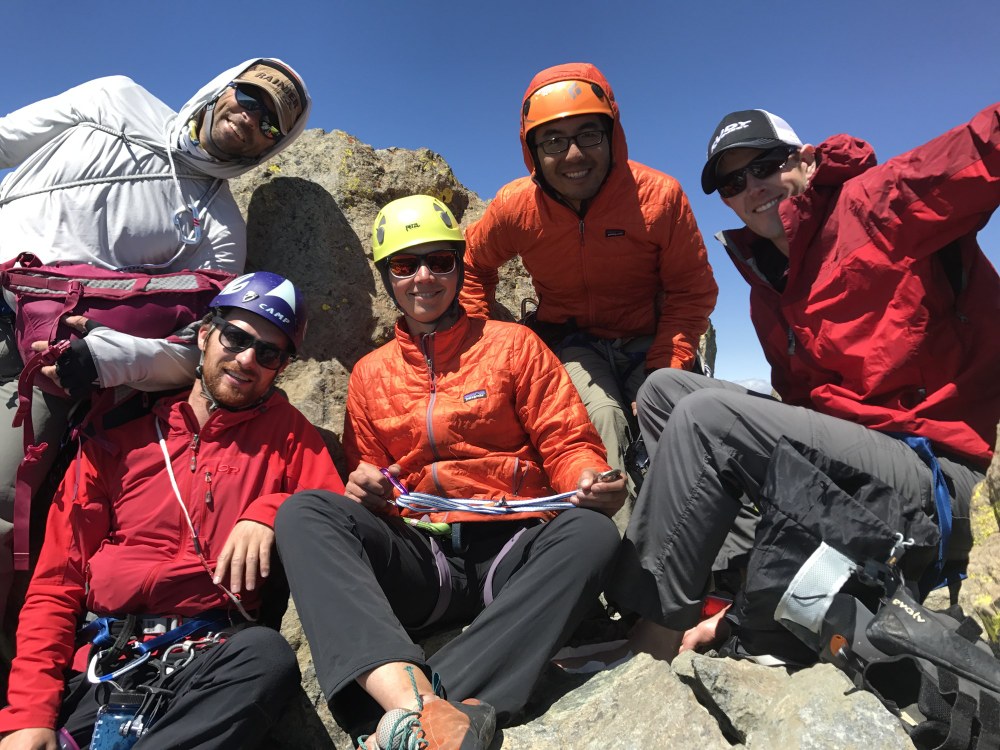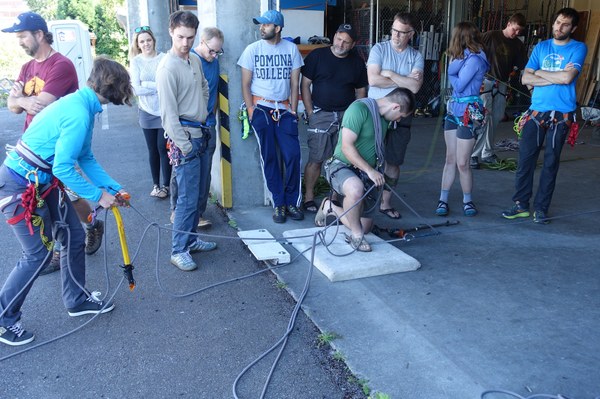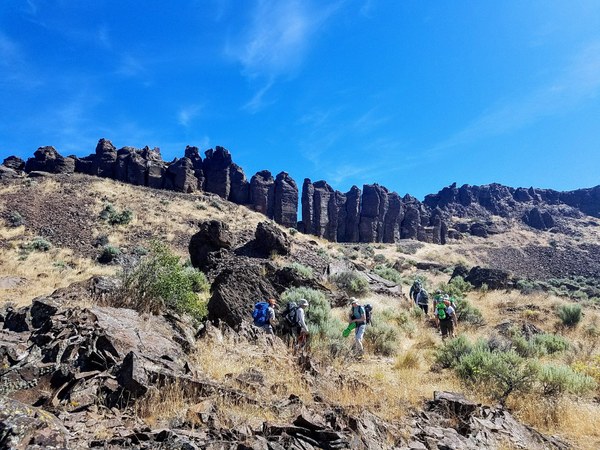
Walking backward, on the roof of the Seattle Program Center, I made my way to the edge. I had doublechecked my rappel system: My anchor, rope, belay device, autoblock, and harness all looked good. Before I unclipped my personal anchor, my instructor gave my system a final sign off.
Sure, I had a few jitters — it's not everyday you find yourself walking off a 35-foot building — but for the most part, I felt good. I was three days into the nine-day Basic Climbing course. Mountaineers Gene Yore and John Ohlson launched this intensive version of The Mountaineers Basic Climbing Course five years ago. It's targeted for those who don't have six months to devote to a course but can take a week off from their lives for a focused mountaineering study
So, here I go off the roof. Rappelling, like all the course skills, was taught in a steady progression. By now, I had rigged systems and rappelled from all sorts of positions and surfaces. My knowledge had been tested and retested. This was the same thing. Just higher.
So when I reached the edge, I declined my instructor’s advice to lower myself down over the side on my butt and ease into my rappel.
‘No, I’ve got this,’ I told myself, imagining all the badass firefighters and Special Forces soldiers in the movies of my youth. They didn’t ease into their rappels! They walked off backward, stances wide, shoulder broad, ready to save the day.
I stepped back, and with a jolt, everyone was out of sight. I was suddenly cradled in my harness, suspended just below the lip of the wall, becoming very intimate with the side of the building. My feet had somehow slipped out from under me. Although I was safe the whole time with my hand on the brake strand of the rope, which was backed up by my autoblock, my attempt at style and grace hardly met the expectations of my youth.
I lowered myself the rest of the way down and returned to the rooftop, where another instructor, Steve Smith, gave me some tips on keeping my feet high to better orient my weight while on rappel. “After all, it’s rappelling, not down climbing,” he said.
This would be one of the countless moments throughout these nine days where I benefitted from the words of a mentor on my climber's journey.
 Leaders demonstrate crevasse rescue at the Seattle Program Center to the 2017 Intense Basic Students. Photo by Steve McClure.
Leaders demonstrate crevasse rescue at the Seattle Program Center to the 2017 Intense Basic Students. Photo by Steve McClure.
An Intensified Course
The Mountaineers’ Basic Alpine Climbing Course has served as the gateway to becoming a competent climbing partner on technical rock, snow, and glaciers for thousands in the Pacific North west over the decades. The traditional course spans six months and includes lectures, field trips, and practice days. It continues to be one of the primary reasons members join the organization. The Intense Basic version takes the same general curriculum and compresses it into nine continuous (and very full) days.
Ambitious? Yes. Sherrie Trecker, who’s led Intense Basic the last couple of years, says, “At first there were a lot of questions. Can students learn all this material in a relatively short amount of time? Will it be successful? I think we’ve shown that it can. Our graduates are very prepared for the challenges of the alpine.”
Over the course of nine days, we went from climbing on practice walls to scaling 100-foot rocks at Vantage; from rehearsing slab techniques in the basement to executing them on Mount Erie; from rigging up crevasse rescues indoors to dangling one another off a huge snow berm on Mount Baker.
From Student to Teacher
One of the course’s biggest accomplishments is that it’s created a pipeline of students who’ve gone on to become volunteer leaders, giving back to the Intense Basic course and other Mountaineers programs. Sherrie took Intense Basic as a student in 2013, and her co-leader for this year’s Intense Basic Course, Steve McClure, took the course in 2014. Our two SIG leaders, Dave Belding and Nick Block, are recent grads as well.
“Seeing the amount of energy the leaders put in motivated me to want to give back in the future,” Sherrie said when discussing her reasons for staying involved. “On more of a selfish level, I also truly think that when you teach you hone your own climbing skills.”
Throughout the course, an array of other leaders – many of them recent Intense Basic grads – joined Sherrie, Steve, Dave, and Nick to help instruct. The course’s rapid pace was matched by the many teachers available to help guide the way, often at a one-to-one ratio.
 Course leader Sherrie Trecker waits for students atop the Seattle Program Center climbing wall. Photo by Steve Smith.
Course leader Sherrie Trecker waits for students atop the Seattle Program Center climbing wall. Photo by Steve Smith.
Course founder John Ohlson said after the first year of Intense Basic, “It’s a lot of information and instruction presented in a short period of time. Because the skill level varied among students, those with more skills and experience started assisting those with less experience. By the end of the course, some had already committed to volunteering next year!”
What worked then continues to work now. Just weeks after my course ended, my fellow students were sharing tips in our Facebook group about how to get involved with the upcoming Intermediate Climbing Course, the next step in The Mountaineers climbing progression.
Climb On
After the Intense Basic course ends, students have the rest of the summer to complete three climbs: one rock, one glacier, and one that the student gets to choose. That’s where the real alpine climbing begins, and it’s also where Sherrie’s been the most impressed with her students.
When I asked her to recall a particularly noteworthy experience from her years in Intense Basic, she didn’t cite a panoramic summit view or a thrilling set of pitches (although she’s enjoyed plenty of both.) She recalled an attempt on Glacier Peak with a group of students. The grueling climb entails a 17-mile hike into camp, a 12-hour summit day, and then another 17-mile hike out.
“The morning of the climb, we woke up to whiteout conditions and decided to go for it anyway,” she said. “An hour into it, we were in a terrible storm. We made the tough decision to turn around. And not only turn around but hike all the way out that day. So we hiked a total of 18 or 19 miles in pouring rain, snow, and wind. We all had to take down camp in that weather. Those students are all still active to this day. That 18 or 19-mile slog didn’t scare them away.”
My First Climb
We met at 5am, at end of the Teanaway River Road, and began our trek toward the summit of Ingalls Peak. This would be the first alpine climb of my life.
I wasn’t the only one. We made a circle for introductions and two fellow students were completing their first alpine climb as well. Helping us get there were Sherrie, the trip leader, and Val Dion and Gerry Chu acting as rope leads.
The approach carried us into the Alpine Lakes Wilderness, where the Stuart Range seemed to rise with the sun, its jagged peaks, spires, and tarns jutting into the hazy skyline. After about four miles of steady incline, we reached Ingalls Lake, a watershed with slabs of red rock at its edges and towering mountains in the distance.
Then the climbing started. I was pretty nervous. We were looking at three pitches in the 5.3 range, hardly a demanding objective, but the course left me with a much-deserved respect for climbing systems and the importance of executing them properly.
My internal dialogue was tense as I checked and rechecked my every move, but the climb went smoothly. The sun was shining, and it felt like the views kept improving as we left the comfort of solid ground and joined ranks with the surrounding peaks.
At the end of the last pitch, we carefully unroped and scrambled to the tippy top. It was pretty special up there. Everyone was left speaking in platitudes, “This is awesome,” “Wow, what a view,” “It’s so amazing up here.” Even now it’s hard to come up with a better description of the summit. I guess that’s the point of climbing: to experience things that words, photos, and movies can never quite capture.
After lunch at the peak, we returned to the bolts to set up our first rappel.
‘Ah, we meet again, my old friend,’ I thought to myself.
I volunteered to go first, and Sherrie asked me if I wanted her to walk me through it, or if I wanted to take a shot at doing it myself.
“How about I try to do it myself, and you let me know if I do anything wrong, and I wait until you give me the full go ahead before I rappel?” I said.
I started setting up my system, got the green light, and began my descent. My feet were high – extra high – in light of my ‘roof incident.’ My instructors had taught me well. Three pitches later, I was back on solid ground, ready to start the hike down with my classmates and teachers – and ready to climb on.
 2017 INTENSE BASIC STUDENTS MAKE THEIR WAY TOWARDS VANTAGE'S ROCK WALLS. PHOTO BY STEVE MCCLURE.
2017 INTENSE BASIC STUDENTS MAKE THEIR WAY TOWARDS VANTAGE'S ROCK WALLS. PHOTO BY STEVE MCCLURE.
The Mountaineers Intense Basic Alpine Climbing Course is offered every summer and includes multiple field trips, lessons, and a copy of Freedom of the Hills. Look for the course on our website or email basic.intense@gmail.com with questions. A discount is given for youth aged 26 and under.
This article originally appeared in our Fall 2017 issue of Mountaineer Magazine. To view the original article in magazine form and read more stories from our publication, click here.
 Peter Dunau
Peter Dunau